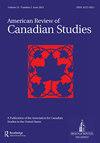玛格丽特·劳伦斯的客厅战争:《火族》中的暴力
IF 0.4
Q3 AREA STUDIES
引用次数: 0
摘要
摘要Margaret Laurence的《火居者》(1969)沉思着世界各地发生的种族化和殖民暴力事件,因为这则新闻将越南战争和非裔美国人被枪杀的画面带到了Stacey MacAindra加拿大的家中。这篇文章评估了劳伦斯所说的小说的“视听”形式。它阅读了小说中对电视报道和报纸照片的描述,以及朱迪斯·巴特勒和苏珊·桑塔格关于战争摄影的作品和卡罗琳·莱文最近关于文学形式的作品。将劳伦斯对“电视战争”的大众化接受以及加拿大对越南和美国暴力事件的反应中着火的房子的中心隐喻置于背景中,这篇文章探讨了小说对约翰·伯杰所说的“痛苦的照片”的关注中所包含的关于道德见证的争论,并认为《火居者》是学者们当前重新评价劳伦斯作为政治作家的重要文本。本文章由计算机程序翻译,如有差异,请以英文原文为准。
Margaret Laurence’s Living-Room War: Bringing Violence Home in The Fire-Dwellers
ABSTRACT Margaret Laurence’s The Fire-Dwellers (1969) meditates on episodes of racialized and colonial violence occurring around the world as the news brings images of the Vietnam War and shootings of African American men into Stacey MacAindra’s Canadian home. This article assesses what Laurence called the novel’s “audio-visual” form. It reads the descriptions of TV reports and newspaper photographs in the novel alongside Judith Butler’s and Susan Sontag’s writing on war photography and Caroline Levine’s recent work on literary forms. Contextualizing Laurence’s central metaphor of the house on fire in the mass-mediated reception of “television’s war” and Canadian responses to violence in Vietnam and the United States, the article examines the debate over ethical witnessing embedded in the novel’s preoccupation with what John Berger called “photographs of agony” and argues that The Fire-Dwellers is an important text for scholars involved in the current reappraisal of Laurence as a political writer.
求助全文
通过发布文献求助,成功后即可免费获取论文全文。
去求助
来源期刊

American Review of Canadian Studies
AREA STUDIES-
CiteScore
0.60
自引率
0.00%
发文量
25
期刊介绍:
American Nineteenth Century History is a peer-reviewed, transatlantic journal devoted to the history of the United States during the long nineteenth century. It welcomes contributions on themes and topics relating to America in this period: slavery, race and ethnicity, the Civil War and Reconstruction, military history, American nationalism, urban history, immigration and ethnicity, western history, the history of women, gender studies, African Americans and Native Americans, cultural studies and comparative pieces. In addition to articles based on original research, historiographical pieces, reassessments of historical controversies, and reappraisals of prominent events or individuals are welcome. Special issues devoted to a particular theme or topic will also be considered.
 求助内容:
求助内容: 应助结果提醒方式:
应助结果提醒方式:


